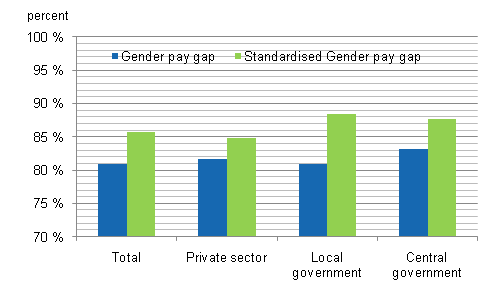Gender pay gap narrowed in 2009
According to Statistics Finland's Structure of Earnings statistics, the gender pay gap narrowed last year when the total earnings of full-time wage and salary earners are compared between 2008 and 2009. While in 2008, women's average monthly earnings were 80.8 per cent of men's earnings; in 2009 the respective proportion was 81.0 per cent, in other words, the gender pay gap narrowed by 0.2 percentage points in one year.Table 1. Monthly earnings by employer sector and gender in 2009
| Employer sector | Women | Men | ratio of wages, % |
| Total | 2 669 | 3 297 | 81,0 |
| Private sector | 2 677 | 3 277 | 81,7 |
| Local government sector | 2 599 | 3 213 | 80,9 |
| Central government sector | 3 007 | 3 614 | 83,2 |
The narrowing of the gender pay gap is explained by the better development of women’s than men’s earnings in 2009. According to the Structure of Earnings statistics, women’s average earnings rose by 3.7 per cent and men’s by 3.5 per cent. According to the fixed index of regular earnings, women’s earnings rose 0.3 per cent more than men’s earnings in the corresponding time period, which means that the change in the structure of wage and salary earners has had a diminishing effect on the development of the gender pay gap measured in the Structure of Earnings data.Women's earnings rose faster than men's in the public sector, while in the private sector earnings rose equally fast among both genders. The pay gap between women and men was the lowest for central government wage and salary earners and the highest for local government wage and salary earners.
Figure 1. Gender pay gap by employer sector in 2009

When comparing the pay gap between women and men it should be noted that the pay received is influenced by such as the person's age and level of education and the employer's industry and location. When these background variables are standardised, or when compared is the pay of wage and salary earners with a corresponding level of education, working in the same occu-pations and in the same industries and areas, the ratio of earnings between the genders is 85.8 per cent according to the Structure of Earnings statistics. Besides gender, this pay gap may be influenced by other factors, such as the competence requirements of the task.
Figure 1 shows that when the background factors are taken into consideration, the pay gap narrows in all employer sectors; especially in the local government sector the pay gap narrows down the most due to standardisation, since the percentage of women there is high and their share of lower pay level tasks is also large.
Source: Structure of Earnings 2009, Statistics Finland
Inquiries: Mika Idman (09) 1734 3445, Jukka Pitkäjärvi (09) 1734 3356, palkkarakenne@stat.fi
Director in charge: Kari Molnar
Updated 12.11.2010
Official Statistics of Finland (OSF):
Structure of Earnings [e-publication].
ISSN=1799-0092. 2009,
Gender pay gap narrowed in 2009
. Helsinki: Statistics Finland [referred: 20.12.2025].
Access method: http://stat.fi/til/pra/2009/pra_2009_2010-11-12_kat_001_en.html

